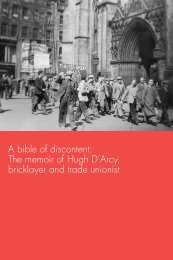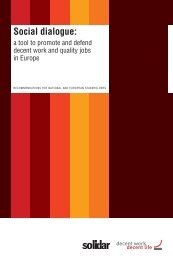Japan – what can we learn? - Construction Labour Research
Japan – what can we learn? - Construction Labour Research
Japan – what can we learn? - Construction Labour Research
Create successful ePaper yourself
Turn your PDF publications into a flip-book with our unique Google optimized e-Paper software.
trans-enterprise or industrial negotiation practice of North Ameri<strong>can</strong>and European unionism.The typical form of the interlinked negotiations is the Spring Struggle(Shunto) which functions as a wage decision mechanism at the macrolevel. Launched about 40 years ago, Shunto is defined as a "unitedstruggle under the united leadership conducted in a specified period inspring every year mainly for wage increase in which as manyindustrial unions as possible are asked to participate." It is a sort of"pattern bargaining" in which otherwise isolated wage bargainingefforts are horizontally linked so as to have the effect of raising wagestandards to the highest possible level. The standard thus establishedwill spread across society and help to raise the general wage level.Shunto-activities are not limited to the spring season alone. TheShunto policymaking begins in the autumn, following unionconventions in the summer that evaluate the previous achievementsand discuss policies of the following year. It is a whole year activityrepeating this cycle every year. In this cycle information is exchangedamong the participating unions helping them formulate final policiesand crystallising a unified will to fight. A pattern-setter union, whosegains have broad ripple effects, benefiting even non-unionisedworkers, usually spearheads the Shunto campaign. Thanks to theseripple effects, the wage levels <strong>can</strong> converge on the level attained bythe Spring Struggle. In this sense, <strong>Japan</strong>ese wage negotiations, thoughbasically decentralized, integrate in them a centralised coordinationmechanism.Without considering this mechanism it would be impossible to explainwhy the wage gap did not grow signifi<strong>can</strong>tly even in theunprecedented long stagnation in the 1990s. Nevertheless, <strong>we</strong> have toadmit that Shunto is at a turning point too. It must change in the faceof the rapidly changing economic environment and aggravatedinternational competition, which is causing yawning capacity gapsamong enterprises. Aware of this, RENGO has begun discussing howShunto <strong>can</strong> be revitalised in the new situation.2.2 Joint consultation system as a channel of communicationAnother characteristic of <strong>Japan</strong>ese industrial relations is that alongwith collective bargaining the management joint consultation systemis a widespread and generally accepted practice. Under this system,representatives of labour and management discuss matters related toCLR News No 2/200654









